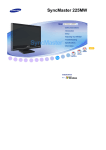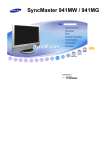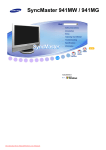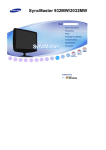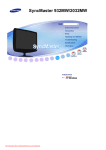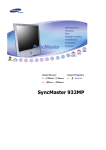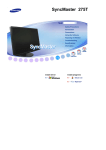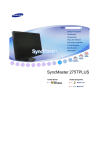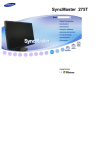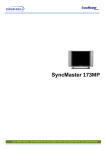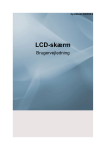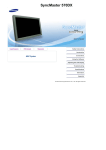Download Samsung 960HD Computer Monitor User Manual
Transcript
SyncMaster 960HD
SyncMaster 960HD
Install Driver
Install Program
Failure to follow directions noted by this symbol could result in bodily harm or damage to the
equipment.
Prohibited
Important to read and understand at all times
Do not disassemble
Disconnect the plug from the outlet
Do not touch
Ground to prevent an electric shock
Power
When not used for extended period of time, set your computer to DPMS.
If using a screen saver, set it to active screen mode.
Do not use a damaged or loose plug.
z
This may cause electric shock or fire.
Do not pull the plug out by the wire nor touch the plug with wet hands.
z
This may cause electric shock or fire.
Use only a properly grounded plug and receptacle.
z
An improper ground may cause electric shock or equipment damage.
Insert the power plug firmly so that it does not come loose.
z
A bad connection may cause fire.
Do not excessively bend the plug and wire nor place heavy objects upon them,
which could cause damage.
z
This may cause electric shock or fire.
Do not connect too many extension cords or plugs to one outlet.
z
This may cause fire.
Do not disconnect the power cord while using the monitor.
z
A surge may be caused by the separation and may damage the monitor.
Do not use the power cord when the connector or plug is dusty.
z
z
If the connector or plug of the power cord is dusty, clean it with a dry cloth.
Using the power cord with a dusty plug or connector may cause an electric
shock or fire.
Installation
Be sure to contact an authorized Service Center, when installing your monitor in a
location with heavy dust, high or low temperatures, high humidity, and exposed to
chemical substances and where it operates for 24 hours such as at airports, train
stations etc.
z
Failure to do so may cause serious damage to your monitor.
Place your monitor in a location with low humidity and a minimum of dust.
z
Failure to do so may cause electric shock or fire inside the monitor.
Do not drop the monitor when moving it.
z
This may cause damage to the product or the person carrying it.
Install the monitor base in a showcase or shelf so that the end of the base does
not protrude from the showcase or shelf.
z
Dropping the product may cause damage to the product or the person carrying
it.
Do not place the product on the floor.
z
Take care, as someone, specifically children may trip over it.
Do not place the product on an unstable or small surface area.
z
Place the product on an even end stable surface ,as the product may fall and
cause harm to someone walking by, specifically children.
Keep any flammable objects such as candles, insecticides or cigarettes away
from the product.
z
Otherwise, this may cause fire.
Keep any heating devices away from the power cable.
z
A melted coating may cause electric shock or fire.
Do not install the product in places with poor ventilation, for instance, a
bookshelf, closet, etc.
z
Any increase in internal temperature may cause fire.
Put down the monitor carefully.
z
The monitor could be damaged or broken.
Do not place the monitor face down.
z
This may damage the TFT-LCD surface.
The installation of the bracket must be done by a qualified professional.
z
z
Installing the bracket by unqualified personnel may result in injury.
Always use the mounting device specified in the owner's manual.
When installing the product, make sure to keep it away from the wall (more
than 10 cm / 4 inches) for ventilation purposes.
z
Poor ventilation may cause an increase in the internal temperature of the
product, resulting in a shortened component life and degraded performance.
To prevent rainwater from running along the outdoor antenna cable and
entering the house, be sure the outdoor portion of the cable hangs down below
the point of entry.
z
If rainwater enters the product, it may cause an electric shock or fire.
If you are using an outdoor antenna, be sure to put sufficient distance between
your antenna and the electrical wires nearby so that they would not come in
contact with each other in case the antenna is knocked over by strong wind.
z
A knocked-over antenna may cause injury or an electric shock.
Keep the plastic packaging (bag) out of children's reach.
z
The plastic packaging (bag) may cause suffocation if children play with it.
Clean
When cleaning the monitor case or the surface of the TFT-LCD screen, wipe with a
slightly moistened, soft fabric.
Do not spray water or detergent directly onto the monitor.
z
This may cause damage, electric shock or fire.
Use the recommended detergent with a smooth cloth.
If the connector between the plug and the pin is dusty or dirty, clean it properly
using a dry cloth.
z
A dirty connector may cause electric shock or fire.
Make sure to unplug the power cord before cleaning the product.
z
Otherwise, this may cause electric shock or fire.
Unplug the power cord from the power outlet and wipe the product using a
soft, dry cloth.
z
Do not use any chemicals such as wax, benzene, alcohol, thinners, insecticide,
air freshener, lubricant or detergent.
Contact a Service Center or Customer Center for interior cleaning once a year.
z
Keep the product's interior clean. Dust which has accumulated in the interior
over an extended period of time may cause a malfunction or fire.
Others
Do not remove the cover (or back).
z
z
This may cause an electric shock or fire.
Refer to a qualified servicing company.
If your monitor does not operate normally - in particular, if there is any unusual
sounds or smell coming from the monitor - unplug it immediately and contact
an authorized dealer or Service Center.
z
This may cause electric shock or fire.
Keep the product away from places exposed to oil, smoke or moisture; do not
install inside a vehicle.
z
z
This may cause a malfunction, electric shock or fire.
In particular, avoid operating the monitor near water or outdoors where it could
be exposed to snow or rain.
If the monitor is dropped or the casing is damaged, turn the monitor off and
unplug the power cord. Then contact a Service Center .
z
The monitor may cause a malfunction, electric shock or fire.
Disconnect the plug from the outlet during storms or lightning or if it is not
used for a long period of time.
z
Failure to do so may cause electric shock or fire.
Do not try to move the monitor by pulling only the wire or the signal cable.
z
This may cause a breakdown, electric shock or fire due to damage to the
cable.
Do not move the monitor right or left by pulling only the wire or the signal
cable.
z
This may cause a breakdown, electric shock or fire due to damage to the
cable.
Do not cover the vents on the monitor cabinet.
z
Bad ventilation may cause a breakdown or fire.
Do not place water containers, chemical products or small metal objects on the
monitor.
z
z
This may cause a malfunction, electric shock or fire.
If a foreign substance enters the monitor, unplug the power cord and contact
the Service Center .
Keep the product away from combustible chemical sprays or inflammable
substances.
z
This may cause an explosion or fire.
Never insert anything metallic into the monitor openings.
z
This may cause electric shock, fire or injury.
Do not insert metal objects such as chopsticks, wire and gimlet or inflammable
objects such as paper and match into the vent, headphone port or AV ports or
etc.
z
It may cause a fire or an electric shock. If an alien substances or water flows
into the product, turn the product off, unplug the power connector from the wall
outlet and contact the Service Center.
If you view a fixed screen for an extended period of time, residual image or
blurriness may appear.
z
Change the mode to energy saving mode or set a screensaver to a changing
picture when away from the monitor for an extended period of time.
Adjust the resolution and frequency to the level appropriate for the model.
z
An inappropriate resolution may cause undesirable picture quality.
19 inch Wide (48 cm) - 1440 X 900
Keep the volume at a comfortable level when using the headphones.
z
Excessively loud volume levels may damage hearing.
Viewing the monitor continuously at a too close angle may result in damage to
your eyesight.
To ease eye strain, take at least a five-minute break after every hour of using
the monitor.
Do not install the product on an unstable, uneven surface or a location prone to
vibrations.
z
Dropping the product may cause damage to the product or the person carrying
it. Using the product in a location prone to vibrations may shorten the lifetime of
the product or may catch fire.
When moving the monitor, turn off and unplug the power cord. Make sure that
all cables, including the antenna cable and cables connected to other devices,
are disconnected before moving the monitor.
z
Failure to disconnect cables may damage it and lead to fire or an electric
shock.
Place the product out of children's reach, as they could damage it by hanging
onto it.
z
A falling product may cause injury to the person or even fatality.
When not using the product for an extended period of time, keep the product
unplugged.
z
Otherwise, this may cause heat emission from the accumulated dirt or
degraded insulation, causing electric shock or fire.
Do not place your children's favorite toys or any other objects of interest on
the product.
z
Children may try to climb on the product to retrieve an object. The product
could fall, causing causing injury or even fatality.
When you remove batteries from the remote, be careful that they are not
swallowed by children. Keep batteries out of the reach of children.
z
If swallowed, see a doctor immediately.
When replacing batteries, place the batteries in the correct +/- polarity position
as indicated on battery holder.
z
Incorrect polarity may cause a battery to break or leak and could lead to fire,
injury, or contamination (damage).
Use only specified standard batteries. Do not use new and used batteries
together.
z
This may cause a battery to break or leak and could lead to fire, injury, or
contamination (damage).
The battery (and rechargeable battery) is not ordinary refuse and must be
returned for recycling purposes. The customer is responsible for returning the
used or rechargeable battery for recycling purposes as the consumer of the
battery.
z
The customer can return the used or rechargeable battery to a nearby public
recycling center or to a store selling the same type of the battery or
rechargeable battery.
When lifting up or moving the monitor, do not lift the monitor upside down
while holding only the stand.
z
This may cause your monitor to fall, and become damaged or cause personal
injury.
Good Postures When Using the Monitor
Try to maintain a good posture when using the monitor.
z
z
z
z
Keep your back straight.
Keep a distance of about 45 ~ 50 cm between your eyes and the
monitor screen. Look at the screen from slightly above it, and
have the monitor directly in front of you.
Tilt the monitor upwards by 10 ~20 degrees. Adjust the monitor
height so that the top of the monitor is slightly below eye level.
Adjust the monitor angle so that there is no reflected light on the
screen.Try to maintain your arms perpendicular to your armpits.
z
Keep your arms level with the back of your hands.
z
Keep the angle of the elbow perpendicular.
Please make sure the following items are included with your monitor.
If any items are missing, contact your dealer.
Contact a local dealer to buy optional items.
Unpacking
Monitor
Manual
Quick Setup Guide
Warranty Card
(Not available in all locations)
User's Guide, Monitor Driver,
Natural Color software
Cable
D-Sub Cable
Audio Cable
Remote Control
Batteries (AAA X 2)
Power Cord
Other
Sold separately
TV Antenna Cable
(Coaxial Cable)
RCA Cable (Video-Yellow,
Audio-Red and White)
Component(PR, PB, Y) Cable
S-VIDEO Cable
Earphones/Headphones
SCART Cable
DVI Cable
Front
1. SOURCE
5. - VOL +
9. Remote Control Sensor
2. PIP
6. [ ] Enter button
10. Speaker
3. MENU
7. [
] Power button
4. CH
8. Power indicator
1. SOURCE
Press the 'SOURCE' button to change the input signal source.
Changing the source is allowed only in external devices that are connected to the monitor
at the time.
To switch Screen modes:
[PC] → [DVI] → [TV] → [Ext.] → [AV] → [S-Video] → [Component]
>>Click here to see an animation clip
According to broadcasting type in each country, you may not be able to choose.
For more information > Broadcasting Systems
2. PIP - Available in PC/DVI Mode
In PC mode, turns on Video or TV screens in PIP mode.
>>Click here to see an animation clip
3. MENU
Use this button for open the on-screen menu and exits from the menu screen or closes
screen adjustment menu.
4.
CH
Moves from one menu item to another vertically or adjusts selected menu values.
In TV mode, selects TV channels.
>>Click here to see an animation clip
5. - VOL +
Moves from one menu item to another horizontally or adjusts selected menu values.
Adjusts the audio volume.
>>Click here to see an animation clip
6. [ ] Enter button
Activates a highlighted menu item.
7. [
] Power button
Turns the monitor On/Off.
8. Power indicator
Power indicator shows PowerSaver mode by green blinking.
9. Remote Control Sensor
Aim the remote control towards this spot on the monitor.
10. Speaker
You can hear sound by connecting the soundcard of your PC to the monitor.
See PowerSaver described in the manual for further information regarding power saving functions.
For energy conservation, turn your monitor OFF when it is not needed or when leaving it unattended
for long periods.
Rear
(The configuration at the back of the monitor may vary from product to product.)
1. POWER
Power terminal
Connect the power cord for your monitor to the POWER on
the back of the monitor.
This product may be used with 100 ~ 240VAC(+/- 10%).
2. DVI/PC IN
DVI/PC IN
1. DVI(HDCP)
: Connect the DVI cable to the DVI(HDCP) port on the
back of your monitor.
2. RGB
: Connect the signal cable to the RGB port on the back
of your monitor.
3. AUDIO
: PC sound terminal (input)
3. EXT(RGB)
External device terminal
As for EXT(RGB) port of the monitor, it makes TV or Video
signal input and output.
4. COMPONENT IN
COMPONENT IN
1. R - AUDIO - L
: DVD/DTV sound input terminal (left/right)
2. PR, PB,Y
: DVD/DTV video input terminal(PR, PB,Y)
5. ANT IN
ANT IN
Connect the CATV cable or TV antenna cable to the "ANT
IN" port on the rear side of the monitor. Make sure to use a
TV antenna cable (sold separately) as the antenna cable.
6.
/ S-VIDEO / VIDEO / L - AUDIO - R
1.
: Headphone sound output terminal
2. S-VIDEO
: External device (S-video) input terminal
3. VIDEO
: External device (video) input terminal
4. L - AUDIO - R
: External device sound input terminal
7.
Kensington Lock
The Kensington lock is a device used to physically fix the
system when using it in a public place.
(The locking device has to be purchased separately.)
For using a locking device, contact where you purchase
it.
See Connecting the monitor for further information regarding cable connections.
Remote Control
The performance of the remote control may be affected by a TV or other electronic device operated near
the monitor, causing malfunction due to interference with frequency.
1.
POWER
2.
Number button
3.
+100, -/--
4.
-
5.
+
MUTE
6.
TTX/MIX
7.
MENU
8.
ENTER
9.
CH/P
10.
SOURCE
11.
INFO
12.
EXIT
13.
Up-Down Left-Right buttons
14. AUTO
15. P.MODE, M/B (MagicBright™)
16. P.SIZE
17. STILL
18. PIP
19.
S.MODE
20.
DUAL/MTS
21.
PRE-CH
22. SOURCE
23. SIZE
24.
POSITION
25. MAGIC-CH
1.
POWER
Turns the monitor On/Off.
2. Number button
Selects TV channels in the TV mode.
Used to change channels when PIP is selected and the PIP Source is set to TV.
3. +100
Press to select channels over 100.
For example, to select channel 121, press "+100", then press "2" and "1".
-/-- (One/Two-Digit channel selection )
Use to select a channel numbered ten or over.
Press this button, and the "--" symbol is displayed.
Enter the two-digit channel number.
4. +
Adjusts the audio volume.
5.
MUTE
Press to mute the sound temporarily.
Displayed on the bottom left of the screen.
Press the MUTE button again to cancel the Mute function.
Alternatively press the + buttons to cancel the Mute function.
6.
TTX/MIX
TV channels provide written information services via teletext.
For more information > TTX / MIX
7.
MENU
Opens the on-screen menu and exits from the menu or closes the adjustment menu.
8.
ENTER
Activates a highlighted menu item.
9.
CH/P
In TV mode, selects TV channels.
10.
SOURCE
Press the 'SOURCE' button to change the input signal source.
Changing the source is only allowed for external devices that are connected to the monitor
at the time.
11.
INFO
Current picture information is displayed on the upper left corner of the screen.
12.
EXIT
Exits from the menu screen.
13.
Up-Down Left-Right buttons
Moves from one menu item to another horizontally, vertically or adjusts selected menu
values.
14. AUTO - Available In PC mode Only
Adjusts the screen display automatically.
15. P.MODE, M/B (MagicBright™)
Press to select a pre-defined Picture Mode of the monitor or to change the picture
atmosphere as required.
When you press this button, current mode is displayed on the lower center of the screen.
TV / AV / Ext. / S-Video /Component : P.MODE
The monitor has four automatic picture settings that are preset at the factory.
Then press the button again to circle through available preconfigured modes.
( Dynamic → Standard → Movie → Custom )
PC / DVI Mode : M/B ( MagicBright™ )
MagicBright™ is a new feature providing the optimum viewing environment depending on
the contents of the image you are watching.
Then press the button again to circle through available preconfigured modes.
( Entertain→ Internet → Text → Custom )
16. P.SIZE - Not available in PC/DVI Mode
Press to change the screen size.
( Auto Wide → Wide → Zoom → 4:3 )
Zoom are not available in 1080i(or over 720p) of DTV.
17. STILL - Operates only for the CVBS, S-Video and RF Signal sources.
Press the button once to freeze the screen. Press it again to unfreeze.
18. PIP - Available in PC/DVI Mode
Push the PIP button to turn PIP screen On/Off.
19.
S.MODE ( Sound Mode )
When you press this button, current mode is displayed on the lower center of the screen.
The monitor has a built-in high fidelity stereo amplifier.
Then press the button again to circle through available preconfigured modes.
( Standard → Music → Movie → Speech → Custom )
20.
DUAL / MTS
DUAL : STEREO/MONO, DUAL l / DUAL ll and MONO/NICAM MONO/NICAM STEREO
can be operated depending on broadcasting type by using DUAL button on the remote
control while watching TV.
MTS : You can select the MTS (Multichannel Television Stereo) mode.
. Mono, Stereo, SAP (Separate Audio Program)
Set 'MTS' to ON to choose Mono, Stereo or SAP.
21.
PRE-CH
This button is used to return to the immediately previous channel.
22. SOURCE - Adjustable when the PIP function is ON.
Selects the Video source.
23. SIZE - Adjustable when the PIP function is ON.
You can switch the PIP picture size.
24.
POSITION - Adjustable when the PIP function is ON.
Changes the Position of the PIP window.
25. MAGIC-CH
MagicChannel enables you to watch only certain channels.
This function is available only in Korea.
Connecting the monitor
1.Connecting to a Computer
1.
Connect the power cord for your monitor to the POWER on the back of the monitor.
Plug the power cord for the monitor into a nearby outlet.
2.
Use a connection appropriate for your computer.
2-1. Using the D-sub (Analog) connector on the video card.
Connect the signal cable to the RGB port on the back of your monitor.
2-2.
3.
Using the DVI (Digital) connector on the video card.
Connect the DVI cable to the DVI(HDCP) port on the back of your monitor.
Connect the (DVI/PC IN) AUDIO port on the rear side of the monitor to the sound card of the PC.
Turn on both your computer and the monitor.
2. Connecting to a Macintosh
1. Using the D-sub (Analog) connector on the video card.
Connect the signal cable to the D-SUB port on the Macintosh computer.
Turn on the monitor and Macintosh.
Connecting to Other devices
This monitor allows the user to connect it to such input devices as a DVD player, a VCR or
camcorder, or a DTV or TV without disconnecting the PC.
The configuration at the back of the monitor may vary from product to product.
1-1. Connecting AV Devices
The monitor has AV connection terminals to connect AV input devices like DVDs, VCRs or
Camcorders. You may enjoy AV signals as long as the monitor is turned on.
1. Input devices such as DVD, VCR or Camcorder are connected to the VIDEO or S-VIDEO terminal
of the monitor using the Video or S-Video cable.
2. Connect the port of the DVD, VCR (DVD / DTV Set-Top Box) to the R-AUDIO-L port of the monitor.
3. Then, start the DVD, VCR or Camcorders with a DVD disc or tape inserted.
4. Select AV or S-Video using the SOURCE.
1-2. Connecting EXT.(RGB) - It only applies to AV DEVICE that
supports SCART.
Connect to the DVD Devices input if the device has a EXT (RGB) jack.
You can watch DVD simply by hooking up the DVD player with the monitor as long as the power
is on.
1. Connect the EXT (RGB) port of the monitor to the DVD Player using a SCART jack.
2. Select Ext. by using the SOURCE.
2. Connecting TV
You may view television programs on the monitor if it is connected to an antenna or CATV cable
without installing any separate TV reception hardware or software on your computer.
1. Connect the CATV cable or TV antenna cable to the "ANT IN" port on the rear side of the monitor.
Make sure to use a TV antenna cable (sold separately) as the antenna cable.
When using an interior antenna terminal:
Check the antenna terminal on the wall first and connect the antenna cable.
When using an outdoor antenna:
If you are using an outdoor antenna, use a professional for installation if possible.
To connect the RF cable to the antenna input terminal:
Keep the copper wire portion of the RF cable straight.
2. Turn on the monitor.
3. Select TV using the SOURCE.
4. Select a desired TV channel.
Is weak signal causing poor reception?
Purchase and install a signal amplifier for better reception.
3. Connecting DVD/DTV Set Top Box
Connect to the DVD/DTVSet Top Box input if the device has a DVD/DTV connector.
You can watch Component simply by hooking up the Component with the monitor as long as the
power is on.
1. Connect the port of the DVD, VCR (DVD / DTV Set-Top Box) to the R-AUDIO-L port of the monitor.
2. Connect the VIDEO OUT port of the DVD / DTV Set-Top Box to the PR, PB,Y input ports using a
component video cable (PR, PB,Y).
3. Select Component using the SOURCE.
4. Connecting Headphone
You may connect your headphones to the monitor.
1. Connect your headphones to the Headphone connection terminal.
Using the Stand
This monitor supports various types of VESA-standard bases.
You need to either fold or remove the base in use in order to install a VESA base.
1. Folding the base
The monitor may be reclined from -1 to 23 degrees.
2. Attaching a base
This monitor accepts a 100 mm X 100 mm VESA-compliant mounting interface pad.
A. Monitor
B. Mounting interface pad (Sold separately)
1. Turn off your monitor and unplug its power cord.
2. Lay the LCD monitor face-down on a flat surface with a cushion beneath it to protect the screen.
3. Turn the fixing screw handle on the stand counterclockwise to loosen it and then separate it from the
stand.
4. Align the Mounting Interface Pad with the holes in the Rear Cover Mounting Pad and secure it with
four screws that came with the arm-type base, wall mount hanger or other base.
To mount the monitor on a wall, you should purchase the wall mounting kit that allows you to
mount the monitor at least 10cm away from the wall surface.
Contact the nearest Samsung Service Center for more information.
Samsung Electronics will not be responsible for damages caused by using a base other than
those specified.
Please use Wall Mount according to the International standards.
Installing the monitor driver (Automatic)
When prompted by the operating system for the monitor driver, insert the CD-ROM included
with this monitor. Driver installation is slightly different from one operating system to
another. Follow the directions appropriate for the operating system you have.
Prepare a blank disk and download the driver program file at the Internet web site shown here.
z Internet web site :
http://www.samsung.com/ (WorldWide)
http://www.samsung.com/monitor (U.S.A)
http://www.sec.co.kr/monitor (Korea)
http://www.samsungmonitor.com.cn/ (China)
1. Insert CD into the CD-ROM drive.
2. Click "Windows"
3. Choose your monitor model in the model list, then click the "OK" button.
4. If you can see following message window, then click the "Continue Anyway" button. Then
click "OK" button. (Microsoft® Windows® XP Operating System)
This monitor driver is under certifying MS logo,and this installation don't damage
your system.The certified driver will be posted on Samsung Monitor Homepage
http://www.samsung.com/
5. Monitor driver installation is completed.
Installing the monitor driver (Manual)
Windows XP | Windows 2000 |Windows Me |Windows NT | Linux
When prompted by the operating system for the monitor driver, insert the CD-ROM included
with this monitor. Driver installation is slightly different from one operating system to
another. Follow the directions appropriate for the operating system you have.
Prepare a blank disk and download the driver program file at the Internet web site shown here.
z Internet web site :
http://www.samsung.com/ (WorldWide)
http://www.samsung.com/monitor (U.S.A)
http://www.sec.co.kr/monitor (Korea)
http://www.samsungmonitor.com.cn/ (China)
Microsoft® Windows® XP Operating System
1. Insert CD into the CD-ROM driver.
2. Click "Start" —> "Control Panel" then click the "Appearance and Themes" Icon.
3. Click "Display" icon and choose the "Settings" tab then click "Advanced..".
4. Click the "Properties" button on the "Monitor" tab and select "Driver" tab.
5. Click "Update Driver.." and select "Install from a list or.." then click "Next" button.
6. Select "Don't search ,I will.." then click "Next" and then click "Have disk".
7. Click the "Browse" button then choose A:(D:\Driver) and choose your monitor model in the model list
and click the "Next" button.
8. If you can see following message window, then click the "Continue Anyway" button. Then click "OK"
button.
This monitor driver is under certified MS logo,and this installation doesn't damage your system.The
certified driver will be posted on Samsung Monitor Homepage.
http://www.samsung.com/
9. Click the "Close" button then click "OK" button continually.
10. Monitor driver installation is completed.
Microsoft® Windows® 2000 Operating System
When you can see "Digital Signature Not Found" on your monitor, follow these steps.
1. Choose "OK" button on the "Insert disk" window.
2. Click the "Browse" button on the "File Needed" window.
3. Choose A:(D:\Driver) then click the "Open" button and then click "OK" button.
How to install
1.
2.
3.
4.
5.
6.
7.
8.
9.
10.
Click "Start" , "Setting" , "Control Panel".
Double click the "Display" Icon.
Choose the "Settings" tab and then click "Advanced..".
Choose "Monitor".
Case1: If the "Properties" button is inactive, it means your monitor is properly configured. Please
stop installation
Case2: If the "Properties" button is active, click the "Properties" button then follow next steps
continually.
Click "Driver" and then click on "Update Driver.." then click on the "Next" button.
Choose "Display a list of the known drivers for this device so that I can choose a specific
driver" then click "Next" and then click "Have disk".
Click the "Browse" button then choose A:(D:\Driver).
Click the "Open" button, then click "OK" button.
Choose your monitor model and click the "Next" button then click "Next" button.
Click the "Finish" button then the "Close" button.
If you can see the "Digital Signature Not Found" window then click the "Yes"button. And click
the "Finish" button then the "Close" button.
Microsoft® Windows® Millennium Operating System
1.
2.
3.
4.
5.
6.
7.
8.
9.
10.
Click "Start" , "Setting" , "Control Panel".
Double click "Display" icon.
Select the "Settings" tab and click "Advanced Properties" button.
Select the "Monitor" tab.
Click the "Change" button in the "Monitor Type" area.
Choose "Specify the location of the driver".
Choose "Display a list of all the driver in a specific location.." then click "Next" button.
Click the "Have Disk" button
Specify A:\(D:\driver) then click "OK" button.
Select "Show all devices" and choose the monitor that corresponds to the one you connected to
your computer and click "OK".
11. Continue choosing "Close" button and "OK" button until you close the Display Properties dialogue
box.
Microsoft® Windows® NT Operating System
1. Click Start, Settings, Control Panel, and then double-click Display icon.
2. In Display Registration Information window, click Settings Tab and then click All Display Modes.
3. Select a mode that you wish to use (Resolution, Number of colors and Vertical frequency) and then
click OK.
4. Click Apply button if you see the screen working normally after clicking Test. If the screen is not
normal, change to a different mode (lower mode of resolution, colors or frequency).
If there is no Mode at All Display Modes, select the level of resolution and vertical frequency
by referring to the Preset Timing Modes in the user guide.
Linux Operating System
To execute X-Window, you need to make the X86Config file, which is a type of system setting file.
1.
2.
3.
4.
5.
6.
7.
8.
9.
Press Enter at the first and the second screen after executing the X86Config file.
The third screen is for setting your mouse.
Set a mouse for your computer.
The next screen is for selecting a keyboard.
Set a Keyboard for your computer.
The next screen is for setting your monitor.
First of all, set a horizontal frequency for your monitor. (You can enter the frequency directly.)
Set a vertical frequency for your monitor. (You can enter the frequency directly.)
Enter the model name of your monitor. This information will not affect the actual execution of XWindow.
10. You have finished setting up your monitor.
Execute X-Window after setting other requested hardware.
Natural Color
Natural Color Software Program
One of the recent problems in using a computer is that the color of the images printed out by a printer
or other images scanned by a scanner or a digital camera are not the same as those shown on the
monitor.
The Natural Color S/W is the very solution for this problem. It is a color administration system
developed by Samsung Electronics in association with Korea Electronics & Telecommunications
Research Institute (ETRI).
This is only available for Samsung monitors and ensures that the color of the images on the monitor
are the same as the printed or scanned images.
For more information, refer to Help (F1) in the software program.
Installing the Natural Color Software
Insert the CD included with the Samsung monitor into the CD-ROM Drive. The initial Natural Color
screen will appear. Click on Natural Color in the startup window to install the Natural Color software.
To install the program manually, insert the CD included with the Samsung monitor into the CD-ROM
Drive, click the Windows [Start] button, select [Execute].
Enter D:\color\NCProSetup.exe and then press the <Enter> key.
(If the drive where the CD is inserted is not D:\, enter the applicable drive.)
Uninstalling the Natural Color Software Program
Select [Settings]/[Control Panel] from the [Start] menu and then double-click [Add/Delete a program].
Select Natural Color from the list and then click the [Add/Delete] button.
Input
Available Source
List
: PC /
DVI
:
TV
:
Ext.
:
AV
: SVideo
:
Component
OSD
Description
Source List
Use to select PC or other external input sources connected to the Monitor.
Use to select the screen of your choice.
- The direct button on the remote control is 'SOURCE' button.
PC
DVI : HDCP supported
TV
Ext.
It is connected to the EXT(RGB) jack of the monitor and the TV or Video
signal is input/output through this jack.
AV
S-Video
Component
PIP
When external A/V devices such as VCRs or DVDs are connected to the
monitor, PIP allows you to watch Video from those devices in a small window
super-imposed on the PC Video signal. (On/Off)
When PIP is in operation, the sound in PIP Source will be selected.
Play/Stop
- Available in PC, DVI modes.
PIP: Turn the PIP Screen on or off.
ON/ Off
- The direct button on the remote control is 'PIP' button.
PIP
Source: Select the input source for the PIP.
Main Source: PC / DVI
PIP Source (Sub): TV / Ext. / AV / S-Video
- The direct button on the remote control is 'SOURCE' button.
Source
Size
Size: Changing the Size of the PIP window.
/
/
If you select
in Size, Position will not be activated.
- The direct button on the remote control is 'SIZE' button.
Position
Position: Changing the Position of the PIP window.
/
/
/
- The direct button on the remote control is 'POSITION' button.
Edit Name
Name the input device connected to the input jacks to make your input
source selection easier.
PC
DVI
Ext.
AV
S-Video
Component
Picture
PC / DVI
Available Source
List
OSD
: PC /
DVI
:
TV
:
Ext.
:
AV
: SVideo
:
Component
Description
MagicBright™ MagicBright™ is a new feature providing the optimum viewing environment
depending on the contents of the image you are watching.
Play/Stop
Currently four different modes are available: Entertain, Internet,Text and
Custom.
Each mode has its own pre-configured brightness value. You can easily
select one of four settings by simply pressing the MagicBright™ control
button.
- The direct button on the remote control is 'M/B' button.
Entertain
For watching motion pictures such as a DVD or VCD.
Internet
For working with a mixture of images such as text and graphics.
Text
For documentations or works involving heavy text.
Custom
Although the values are carefully chosen by our engineers, the preconfigured values may not be comfortable to your eyes depending on your
taste. If this is the case, adjust the Brightness and Contrast by using the
OSD menu.
Custom
You can use the on-screen menus to change the contrast and brightness
according to personal preference.
Contrast
: Adjust the Contrast.
Brightness
: Adjust the Brightness.
If you adjust picture using Custom function, MagicBright will turn to Custom mode.
Colour Tone
The tone of the color can be changed.
Available in PC/DVI Mode Only
The individual color DTVs are also user customizable.
PC : Cool / Normal / Warm / Custom
DVI : Cool / Normal / Warm
Colour
Control
Adjust the individual R, G, B Colour Controls.
- Available in PC Mode Only
Red
Green
Blue
If you adjust picture using Colour Control function, Colour Tone will turn to Custom
mode.
Image Lock
Image Lock is used to fine tune and get the best image by removing noise
that creates unstable images with jitter and shimmer. If satisfactory results
are not obtained using the Fine adjustment, use the Coarse adjustment and
then use Fine again.
- Available in PC Mode Only
Coarse
: Removes noise such as vertical stripes. Coarse adjustment may move
the screen image area. You may relocate it to the center using the
Horizontal Control menu.
Fine
: Removes noise such as horizontal stripes. If the noise persists even
after Fine tuning, repeat it after adjusting the frequency (clock speed).
Sharpness
- When the Source is set to DVI, only this function operates.
: Adjust the Sharpness.
Position
: Adjusts the screen location horizontally and vertically.
Auto
Adjustment
The values of Fine, Coarse, Position are adjusted automatically.
If you change resolution in the control panel, Auto function will be executed.
- The direct button on the remote control is 'AUTO' button.
- Available in PC Mode Only
Size
You can switch the Size.
Wide
4:3
PIP Picture
You can adjust the PIP Screen Settings.
Contrast
: Adjusts the Contrast of the PIP window on the screen.
Brightness
Coarse / Fine
Sharpness
Position
: Adjusts the Brightness of the PIP window on the screen.
Sharpness
: Adjusts the Sharpness of the PIP window on the screen.
Colour
: Adjusts the Color of the PIP window on the screen.
Source List : TV / Ext. / AV / S-Video / Component
Available Source
List
: PC /
DVI
:
TV
:
Ext.
:
AV
: SVideo
:
Component
OSD
Description
Mode
The monitor has four automatic picture settings ("Dynamic", "Standard",
"Movie", and "Custom") that are preset at the factory.
You can activate either Custom, Dynamic, Standard, or Movie.
You can select "Custom" which automatically recalls your personalized
picture settings.
- The direct button on the remote control is 'P.MODE' button.
Dynamic
: Select this mode to view a sharper image than in "Standard" mode.
Standard
: Select this mode when the surroundings are bright.
This also provides a sharp image.
Movie
: Select this mode when the surroundings are dark.
This will save power and reduce eye fatigue.
Custom
: Select this mode when you want to adjust the image according to your
preferences
Custom
You can use the on-screen menus to change the contrast, and brightness
according to personal preference.
Contrast
: Adjusts the Contrast.
Brightness
: Adjusts the Brightness.
Sharpness
: Adjust the Sharpness.
Colour
: Adjust the picture Color.
Colour Tone The tone of the color can be changed.
Available in PC/DVI Mode Only
The individual color Components are also user customizable.
Cool2 / Cool1 / Normal / Warm1 / Warm2
Play/Stop
Size
You can switch the Size.
- The direct button on the remote control is 'P.SIZE' button.
Auto Wide / Wide / Zoom / 4:3
Zoom is not available in 1080i(or over 720p) of DTV.
Sound
Available Source
List
: PC /
DVI
:
TV
:
Ext.
:
AV
: SVideo
:
Component
OSD
Description
Mode
The monitor has a built-in high fidelity stereo amplifier.
- The direct button on the remote control is 'S.MODE' button.
Standard
: Choose Standard for the standard factory settings.
Music
: Choose Music when watching music videos or concerts.
Movie
: Choose Movie when viewing movies.
Speech
: Choose Speech when watching a show that is mostly dialogue (i.e.,
news).
Custom
: Choose Custom if you want to adjust the settings according to personal
preference.
Custom
The sound settings can be adjusted to suit your personal preference.
Bass
: Emphasize low frequency audio.
Treble
: Emphasize high frequency audio.
Balance
: Allows you to adjust the sound balance between the left and right
speakers.
Balance allows you to adjust the sound balance between the left and
Play/Stop
right speakers and you can hear the sound even when the sound
value is set to 0.
Auto
Volume
Reduces the differences in volume level among broadcasters.
On /Off
Dolby
Virtual
Dolby Virtual Sound On/Off (Dolby Virtual simulates the effect of the Dolby
Surround sound system, recreating the movie-theatre or concert-hall- quality
sound.)
On /Off
BBE
BBE High Definition Sound is a proprietary audio enhancement technology
that compensates for phase and amplitude distortion inherent in the nature of
loudspeaker physics. BBE works like an automatic focus in a camera,
bringing incredible clarity, depth and detail to the sound.
On
Off
Switching BBE On changes the Mode to Standard, switches Dolby Virtual Off, and
deactivates Custom. Selecting a Mode other than Standard Mode, switches BBE Off even
if you have switched BBE On.
Sound
Select
You can select either Main or Sub when PIP is On.
Main / Sub
Channel
Available Source
List
: PC /
DVI
:
TV
:
Ext.
:
AV
: SVideo
:
Component
OSD
Description
Country
Select the country in which the product is being used before you use the
Auto Store feature. If you do not see your country in the list, select Other.
Belgium, France, Germany, Italy, Netherlands, Spain, Sweden,
Switzerland, UK, Others, CIS, E.Europe
Auto Store You can scan the frequency ranges available on your television in your area
and store all the channels found automatically.
The following Countries are available.
Play/Stop
Manual
Store
You can scan the frequency ranges available on your television in your area and
store all the channels found manually.
Programme:
Inputting the appropriate program number on the screen.
Colour System:
Adjust repeatedly until the color is of the best quality.
AUTO, PAL, SECAM, NT4.43
Sound System:
Adjust repeatedly until the sound is of the best quality.
BG , DK, I, L
Channel :
Choosing the air channel through the adjustment of up/down under the
current frequency.
Search :
The tuner scans the frequency range until the first channel or the channel
that you selected is received on your screen.
Store :
It's used to restore the number user inputs.
Add/Delete Selecting Add registers the channel and selecting Delete deregisters the
registered channel.
Sort
It's used to exchange the numbers of two channels.
Name
If channel name information is broadcast when you store the channels either
manually or automatically, the names are assigned to the channels directly.
You can however change these names or assign new names as required.
Fine Tune
Due to weak signals or an incorrect antenna configuration, some of the
channels may not be tuned correctly.
Setup
Available Source
List
OSD
Description
: PC /
DVI
:
TV
:
Ext.
:
AV
: SVideo
:
Component
Play/Stop
Area
When you turn the power on of the product for the first time since it released
Configuration from a factory, menu to select location will appear.
Choose the region and country where you use the monitor.
This is because broadcasting type varies according to region and country.
You can select broadcasting type in OSD menu as well by selecting MENUSetup-Area Configuration.
This product can be used worldwide if area configuration is set
up regardless of broadcasting type.
If country is not selected properly, the product may not locate
channels.
Language
You can choose one of 8 languages.
The selected language is only applied in the Monitor Screen
Settings menu.
It has no effect on any software running on the computer.
Sleep Timer
Turns the monitor off after a pre-determined period of time.
Off, 30, 60, 90, 120, 150, 180
Transparency Change the opaqueness of the background of the OSD.
High
Medium
Low
Opaque
Blue Screen
If no signal is being received or the signal is very weak, a blue screen
automatically replaces the noisy picture background. If you wish to continue
viewing the poor picture, you must set the "Blue screen" mode to "Off".
On / Off
Reset
Picture parameters are replaced with the factory default values.
- Available in PC Mode Only
Image Reset
: Image parameters are replaced with the factory default values.
Colour Reset
: Color parameters are replaced with the factory default values.
Image Reset
Colour Reset
Self-Test Feature Check
Check the following items yourself before calling for service. Contact the service center for
problems that you cannot solve by yourself.
Self-Test Feature Check | Not Optimum Mode | Display Adapter Driver
Maintenance and Cleaning | Symptoms & Recommended Actions
1. Self-Test Feature Check
Your monitor provides a self test feature that allows you to check whether your monitor is functioning
properly.
1. Turn off both your computer and the monitor.
2. Unplug the video cable from the back of the computer.
3. Turn on the monitor.
The figure shown below ("Check Signal Cable") appears on a black background when the monitor is
in its normal working condition though it does not sense any video signal: While in the Self-Test
mode, the LED power indicator remains green and the figure moves around on the screen.
4. Turn off your monitor and reconnect the video cable; then turn on both your computer and the
monitor.
If your monitor screen remains blank after using the previous procedure, check your video controller and
computer system; your monitor is functioning properly.
2. Not Optimum Mode
If the vertical resolution is not optimum mode, you can still see the display but the warning message below
appears and disappears after one minute.
The user must adjust the frequency within that one minute.
Refer to Specifications > Preset Timing Modes for the resolutions or frequencies that are
supported by the monitor.
3. Display Adapter Driver
Display adapter refers to the computer video card driver.
If the adapter is not properly set, you cannot adjust resolution, frequency or color and you cannot
install the monitor driver.
1. Checking Adapter Driver
Click Start
Settings
Control Panel
Display
Settings
Advanced
Adapter.
If "Default" or a wrong product model is indicated, it means that the adapter driver is not properly
installed. Install the adapter driver again according to the information provided by the computer or
video card manufacturers.
2. Installing Adapter Driver
The instructions given below are for general circumstances.
For specific issues, contact the relevant computer or video card manufacturers.
1) Click Start
Settings
Control Panel
Display
Settings
Advanced
Adapter
Update Driver
Next
Display a list of the known drivers for this device so
that I can choose a specific driver
Next
Have Disk (Insert Video Card Driver diskette)
OK
Next
Next
Finish.
2) In case you have Adapter Driver Setup file on your computer:
Run Setup.exe or Install.exe, which is found in the Adapter Driver Setup file.
4. Maintenance and Cleaning
1. Maintaining the Monitor Case.
Clean with a soft cloth after disconnecting the power cord.
z
z
Do not use benzene, thinner or other flammable substances, or a
wet cloth.
We recommend a Samsung cleansing agent is used to prevent
damage to the screen.
2. Maintaining the Flat Panel Display Screen.
Clean with a soft cloth (cotton flannel) smoothly.
z
z
Never use acetone, benzene or thinner.
(They may cause flaws or deformation of the screen surface.)
The user will be required to pay costs and related expenses for
repair of damages caused by him/her.
5. Symptoms and Recommended Actions
A monitor recreates visual signals received from the computer. Therefore, if there is trouble with
the computer or the video card, this can cause the monitor to become blank, have poor coloring,
noise, Video mode not supported, etc. In this case, first check the source of the problem, and
then contact a service center or your dealer.
1. Check if the power cord and the video cables are properly connected to the computer.
2. Check if the computer beeps more than 3 times when booting.
(If it does, request an after-service for the main board of the computer.)
3. If you installed a new video card or if you assembled the PC, check if you installed the adapter(video)
driver and the monitor driver.
4. Check if the scanning ratio of the video screen is set at 56 Hz or 75 Hz.
(Do not exceed 60 Hz when using the maximum resolution.)
5. If you have problems in installing the adapter (video) driver, boot the computer in Safe Mode, remove
the Display Adapter at the "Control Panel, System, Device Administrator" and then reboot the
computer to reinstall the adapter (video) driver.
The following table lists possible problems and their solutions. Before calling for service, check
the information in this section to see if you can remedy any problems yourself. If you do need
assistance, please call the phone number on the Information section or contact your dealer.
Installation | Screen | Audio | Remote Control
1. Problems related to Installation
Problems related to the monitor installation and their solutions are listed.
Problems
PC
Mode
Solutions
It appears the PC does not
function normally.
z
The monitor screen flickers.
TV
Mode
z
TV screen is blurred or
shows noise signals.
z
TV signal is not received
z
z
Check if the Display Adapter Driver (VGA Driver) is
properly installed.
(Refer to Installing Driver)
Check if the signal cable between the computer and
the monitor is securely connected and tightened.
(Refer to Connecting to a monitor)
Check if the TV antenna connector is securely
connected to the external antenna.
(Refer to Connecting to TV)
Check "Channel system" and make sure you choose
the correct channel system.
(Refer to the Channel System)
Select "Auto Store" to configure the channel system
automatically. (Refer to the Auto Store)
2. Problems related to Screen
Problems related to the monitor screen and their solutions are listed.
Problems
Screen is blank and power
indicator is off
"Check Signal Cable" message
Solutions
z
z
z
"Not Optimum Mode" message
z
z
Picture rolls vertically.
Image is not clear. Picture is
blurred.
z
z
z
z
Picture image is unstable and
vibrates.
z
Ghost images are shown in the
picture.
The image is too light or too dark
z
Screen color is inconsistent.
z
Color image is distorted with
Ensure that the power cord is firmly connected and the LCD
monitor is on.
(Refer to the Connecting the Monitor)
Ensure that the signal cable is firmly connected to the PC or
video sources.
(Refer to the Connecting the Monitor)
Ensure that the PC or video sources are turned on.
Check the maximum resolution and the frequency of the
video adapter.
Compare these values with the data in the Preset Timing
Modes Chart.
Check if the signal cable is securely connected.
Connect it again securely.
(Refer to Connecting to a monitor)
Run Frequency Coarse and Fine tuning.
Turn on again after removing all accessories
(video extension cable, etc.)
Set resolution and frequency to the recommended ranges.
Check if the resolution and frequency set for the computer
video card falls in the range supported by the monitor.
If not, reset them referring to the current Information under
the monitor menu and Preset Timing Modes.
Adjust the Brightness and Contrast.
(Refer to the Brightness, Contrast)
Adjust color using Custom under OSD Color Adjustment
menu.
dark shadows.
White color is poor.
Power Indicator blinks green.
z
Screen is blank and power
indicator light is steady green or
blinks every 0.5 or 1 seconds
z
z
The screen is blank and is
blinking.
z
The monitor is currently saving the changes made in settings
to the OSD memory.
The monitor is using its power management system.
press a key on the keyboard
If you see the "TEST GOOD" message on the screen when
you press the MENU button, check the cable connection
between the monitor and the computer to ensure that the
connector is properly connected.
3. Problems related to Audio
Problems related to audio signals and their solutions are listed below.
Problems
Solutions
No sound
z
z
Sound level is too low.
z
Check the volume level.
(Refer to the Volume)
If the volume is still too low after turning the control to its
maximum, check the volume control on the computer sound
card or software program.
z
Adjust the Treble and Bass to appropriate level.
z
Sound is too high pitched or too
low pitched
Ensure that the audio cable is firmly connected to both the
audio-in port on your monitor and the audio-out port on your
sound card.
(Refer to the Connecting the Monitor)
Check the volume level.
(Refer to the Volume)
4. Problems related to Remote Control
Problems related to the remote control and their solutions are listed.
Problems
The remote control buttons do
not respond.
Items to check
z
z
z
z
z
Check the battery polarities (+/-).
Check if the batteries have been exhausted.
Check if the power is on.
Check if the power cord is securely connected.
Check if a special fluorescent or neon lamp is on in the
vicinity.
Q&A
Question
How can I change the frequency?
Answer
Frequency can be changed by reconfiguring the video card.
Note that video card support can vary, depending on the version of the
driver used. (Refer to the computer or the video card manual for
details.)
How can I adjust the resolution?
Windows ME/XP/2000 : Set the resolution at the Control
Panel˧Display˧Settings.
* Contact the video card manufacturer for details.
How can I set the Power Saving
function?
Windows ME/XP/2000 : Set the function at BIOS-SETUP of the
computer or the screen saver. (Refer to Windows/Computer Manual).
How can I clean the outer
case/LCD Panel?
Disconnect the power cord and then clean the monitor with a soft cloth,
using either a cleaning solution or plain water.
Do not leave any remains of the detergent nor scratch the case. Do not
allow any water to go inside the monitor.
General
General
Model Name
SyncMaster 960HD
LCD Panel
Size
19.0 inch diagonal (48 cm)
Display area
408.24 mm(H) x 255.15 mm(V)
Pixel Pitch
0.2835 mm(H) x 0.2835 mm(V)
Synchronization
Horizontal
30 ~ 61 kHz
Vertical
56 ~ 75 Hz
Display Color
16.7 M Colors
Resolution
Optimum resolution
WXGA+ 1440 x 900 @ 60 Hz
Maximum resolution
WXGA+ 1440 x 900 @ 60 Hz
Input Signal, Terminated
RGB Analog, DVI(Digital Visual Interface)
Composite Digital RGB, 0.7Vp-p±5%, Positive bright, 75Ω±10%(terminated),
Separate H/V sync, Composite,TTL level, positive or negative
TV / Video
Color system
NTSC-M, PAL-M/N, PAL/SECAM - L/L',B/G,D/K,I
Video format
S-Video, Composite, Component, Built-in-Tuner, PIP
Maximum Pixel Clock
81 MHz
Power Supply
AC 100 - 240 V~ (+/- 10 %), 50/60 Hz
Signal Cable
15pin to 15pin D-sub cable, Detachable
DVI-D to DVI-D connector, Detachable (Option)
Signal connectors
15pin 3-row D-sub connector, 24pin 3-row DVI-D connector
Dimensions (WxHxD)/ Weight
466 x 406 x 217 mm / 18.3 x 16.0 x 8.5 inch / 6.2 kg / 13.7 lbs (With Stand)
466 x 371 x 66 mm /18.3 x 14.6 x 2.6 inch (Without Stand)
VESA Mounting Interface
100 mm X 100 mm (for use with Specialty(Arm) Mounting hardware.)
Environmental considerations
Operating
Temperature: 50°F ~ 104°F(10°C ~ 40°C)
Humidity: 10% to 80%, Non-condensing
Storage
Temperature: -4 °F ~113 °F(-20 °C ~ 45 °C)
Humidity: 5% to 95%, Non-condensing
Plug and Play Capability
This monitor can be installed on any Plug & Play compatible system. The interaction of the monitor and the
computer systems will provide the best operating conditions and monitor settings. In most cases, the monitor
installation will proceed automatically, unless the user wishes to select alternate settings.
Dot Acceptable
TFT LCD panel manufactured by using advanced semiconductor technology with precision of 1ppm(one
millionth) above is used for this product. But the pixels of RED, GREEN, BLUE and WHITE color seem to be
bright sometimes or some of black pixels could be seen. This is not from bad quality and you can use it
without uneasiness.
z For example, the number of TFT LCD sub pixels contained in this product are 3,888,000.
Note: Design and specifications are subject to change without prior notice.
Class B Equipment (Information Communication equipment for residential use)
This product complies with the Electromagnetic Compatibility Directives for residential use and can be used in
all areas including common residential areas.
(Class B equipment emits less electromagnetic waves than Class A equipment.)
PowerSaver
This monitor has a built-in power management system called PowerSaver. This system saves energy by
switching your monitor into a low-power mode when it has not been used for a certain amount of time. The
monitor automatically returns to normal operation when you press a key on the keyboard. For energy
conservation, turn your monitor OFF when it is not needed, or when leaving it unattended for long periods. The
PowerSaver system operates with a VESA DPMS compliant video card installed in your computer. Use the
software utility installed on your computer to set up this feature.
State
Normal Operation
Power saving mode
Power off
Power Indicator
Green
Green, Blinking
Black
Power Consumption
Analog/Digital
Less than 55 W
Analog/Digital
Less than 2 W
(Off-mode)
Less than 2 W
(110Vac)
Preset Timing Modes
If the signal transferred from the computer is the same as the following Preset Timing Modes, the screen will
be adjusted automatically. However, if the signal differs, the screen may go blank while the power LED is on.
Refer to the video card manual and adjust the screen as follows.
Table 1. Preset Timing Modes
Horizontal
Frequency
(kHz)
Vertical
Frequency
(Hz)
Pixel Clock
(MHz)
Sync Polarity
(H/V)
MAC, 640 x 480
35.000
66.667
30.240
-/-
MAC, 832 x 624
49.726
74.551
57.284
-/-
MAC,1152 x870
68.681
75.062
100.000
-/-
IBM, 640 x 350
31.469
70.086
25.175
+/-
IBM, 640 x 480
31.469
59.940
25.175
-/-
IBM, 720 x 400
31.469
70.087
28.322
-/+
VESA, 640 x 480
37.500
75.000
31.500
-/-
VESA, 640 x 480
37.861
72.809
31.500
-/-
VESA, 800 x 600
35.156
56.250
36.000
+/+
VESA, 800 x 600
37.879
60.317
40.000
+/+
VESA, 800 x 600
48.077
72.188
50.000
+/+
VESA, 800 x 600
46.875
75.000
49.500
+/+
VESA, 1024 x 768
48.363
60.004
65.000
-/-
VESA, 1024 x 768
56.476
70.069
75.000
-/-
VESA, 1024 x 768
60.023
75.029
78.750
+/+
VESA, 1280 X 960
60.000
60.000
108.00
+/+
VESA, 1280 X1024
63.981
60.020
108.00
+/+
VESA, 1280X1024
79.976
75.025
135.00
+/+
VESA, 1440 x 900
55.935
59.887
106.5
-/+
Display Mode
Horizontal Frequency
The time to scan one line connecting the right edge to the left edge of the
screen horizontally is called the Horizontal Cycle and the inverse number of
the Horizontal Cycle is called the Horizontal Frequency. Unit: kHz
Vertical Frequency
Like a fluorescent lamp, the screen has to repeat the same image many
times per second to display an image to the user. The frequency of this
repetition is called the Vertical Frequency or Refresh Rate. Unit: Hz
Countries
Israel
Denmark
Portugal
Netherlands
Austria
Singapore
Indonesia
Australia
England
South Africa
Hongkong
China
North Korea
Rumania
Brazil
SECAM
Broadcasting
Systems
SECAM-B
Countries
Argentina
Uruguay
Paraguay
SECAM-D
Iran
Iraq
Saudi arabia
Syria
Lebanon
Egypt
SECAM-K1
Russia
Hungary
Bulgaria
Poland
SECAM-L
France
Horizontal Frequency
The time to scan one line connecting the right edge to the left edge of the
screen horizontally is called the Horizontal Cycle and the inverse number of
the Horizontal Cycle is called the Horizontal Frequency. Unit: kHz
Vertical Frequency
Like a fluorescent lamp, the screen has to repeat the same image many
times per second to display an image to the user. The frequency of this
repetition is called the Vertical Frequency or Refresh Rate. Unit: Hz
Contact SAMSUNG WORLDWIDE
If you have any questions or comments relating to Samsung products, please contact
the SAMSUNG customer care center.
North America
U.S.A
1-800-SAMSUNG (7267864)
http://www.samsung.com
CANADA
1-800-SAMSUNG (7267864)
http://www.samsung.com/ca
MEXICO
01-800-SAMSUNG (7267864)
http://www.samsung.com/mx
Latin America
ARGENTINE
0800-333-3733
http://www.samsung.com/ar
BRAZIL
4004-0000
http://www.samsung.com/br
CHILE
800-726-7864 (SAMSUNG)
http://www.samsung.com/cl
COLOMBIA
01 8000 112 112
http://www.samsung.com/co
COSTA RICA
0-800-507-7267
http://www.samsung.com/latin
ECUADOR
1-800-10-7267
http://www.samsung.com/latin
EL SALVADOR
800-6225
http://www.samsung.com/latin
GUATEMALA
1-800-299-0013
http://www.samsung.com/latin
JAMAICA
1-800-234-7267
http://www.samsung.com/latin
PANAMA
800-7267
http://www.samsung.com/latin
PUERTO RICO
1-800-682-3180
http://www.samsung.com/latin
REP. DOMINICA
1-800-751-2676
http://www.samsung.com/latin
TRINIDAD & TOBAGO
1-800-7267-864
http://www.samsung.com/latin
VENEZUELA
1-800-100-5303
http://www.samsung.com/latin
Europe
BELGIUM
02 201 2418
http://www.samsung.com/be
CZECH REPUBLIC
844 000 844
http://www.samsung.com/cz
DENMARK
38 322 887
http://www.samsung.com/dk
FINLAND
09 693 79 554
http://www.samsung.com/fi
FRANCE
08 25 08 65 65 (€ 0,15/min)
http://www.samsung.com/fr
GERMANY
01805 - 121213 (€ 0,12/Min)
http://www.samsung.de
HUNGARY
06 40 985 985
http://www.samsung.com/hu
ITALIA
199 153 153
http://www.samsung.com/it
LUXEMBURG
02 261 03 710
http://www.samsung.lu
NETHERLANDS
0900 20 200 88 (€ 0.10/Min)
http://www.samsung.com/nl
NORWAY
231 627 22
http://www.samsung.com/no
POLAND
0 801 801 881
http://www.samsung.com/pl
PORTUGAL
80 8 200 128
http://www.samsung.com/pt
SLOVAKIA
0850 123 989
http://www.samsung.com/sk
SPAIN
902 10 11 30
http://www.samsung.com/es
SWEDEN
08 585 367 87
http://www.samsung.com/se
U.K
00870 SAMSUNG (7267864),
0818 717 100 (Republic of Ireland)
http://www.samsung.com/uk
CIS
RUSSIA
8-800-200-0400
http://www.samsung.ru
UKRAINE
8-800-502-0000
http://www.samsung.com/ur
Asia Pacific
AUSTRALIA
1300 362 603
http://www.samsung.com/au
CHINA
800-810-5858, 010- 6475 1880
http://www.samsung.com.cn
HONG KONG
2862 6001
http://www.samsung.com/hk
INDIA
3030 8282, 1800 1100 11
http://www.samsung.com/in
INDONESIA
0800-112-8888
http://www.samsung.com/id
JAPAN
0120-327-527
http://www.samsung.com/jp
MALAYSIA
1800-88-9999
http://www.samsung.com/my
PHILIPPINES
1800-10-SAMSUNG (7267864)
http://www.samsung.com/ph
SINGAPORE
1800-SAMSUNG (7267864)
http://www.samsung.com/sg
THAILAND
1800-29-3232, 02-689-3232
http://www.samsung.com/th
TAIWAN
0800-329-999
http://www.samsung.com/tw
VIETNAM
1 800 588 889
http://www.samsung.com/vn
Middle East & Africa
SOUTH AFRICA
0860 7267864 (SAMSUNG)
http://www.samsung.com/za
U.A.E
800SAMSUNG (7267864)
http://www.samsung.com/mea
Terms
Sync Signal
Sync (Synchronized) Signals refer to the standard signals that are required to display desired colors on
the monitor. They are divided into Vertical and Horizontal Sync Signals. These signals display normal
color images by the set resolution and frequency.
Types of Sync Signals
Separate
This is a scheme of transmitting individual vertical and horizontal sync signals to
the monitor.
Composite
This is a scheme of combining vertical and horizontal sync signals into one
composite signal and transmitting it to the monitor. The monitor displays the
color signals by separating the composite signal into original color signals.
Dot Pitch
The image on a monitor is composed of red, green and blue dots. The closer the dots, the higher the
resolution. The distance between two dots of the same color is called the 'Dot Pitch'. Unit: mm
Vertical Frequency
The screen must be redrawn several times per second in order to create and display an image for the
user. The frequency of this repetition per second is called the Vertical Frequency or Refresh Rate. Unit:
Hz
Example:
If the same light repeats itself 60 times per second, this is regarded as 60 Hz.
Horizontal Frequency
The time to scan one line connecting the right edge to the left edge of the screen horizontally is called
the Horizontal Cycle. The inverse number of the Horizontal Cycle is called Horizontal Frequency. Unit:
kHz
Interlace and Non-Interlace Methods
Showing the horizontal lines of the screen from the top to the bottom sequentially is called the NonInterlace method while showing odd lines and then even lines in turn is called the Interlace method.
The Non-Interlace method is used for the majority of monitors to ensure a clear image. The Interlace
method is the same as that used in TVs.
Plug & Play
This is a function that provides the best quality screen for the user by allowing the computer and the
monitor to exchange information automatically. This monitor follows the international standard VESA
DDC for the Plug & Play function.
Resolution
The number of horizontal and vertical dots used to compose the screen image is called the 'resolution'.
This number shows the accuracy of the display. A high resolution is good for performing multiple tasks
as more image information can be shown on the screen.
Example: If the resolution is 1440 x 900, this means the screen is composed of 1440 horizontal dots
(horizontal resolution) and 900 vertical lines (vertical resolution).
RF Cable
A round signal cable generally used for TV antennas.
Satellite Broadcasting
Broadcasting service provided via satellite. Enables high picture quality and clear sound throughout the
country regardless of the location of the viewer.
Sound Balance
Balances the levels of the sound coming from each speaker in televisions with two speakers.
Cable TV
Whereas the terrestrial broadcasting is delivered via frequency signals through the air, cable
broadcasting is transmitted via a cable network. In order to view cable TV, one must purchase a cable
receiver and hook it up to the cable network.
CATV
"CATV" refers to the broadcasting service offered at hotels, schools and other buildings through their
own broadcasting system, apart from VHF or UHF broadcasting by terrestrial broadcasters. The CATV
programs may include movies, entertainment and educational programs. (Different from cable TV.)
CATV can be viewed only within the area in which the CATV service is offered.
S-Video
Short for "Super Video." S-Video allows up to 800 lines of horizontal resolution, enabling high-quality
video.
VHF/UHF
VHF indicates TV channels 2 to 13, and UHF indicates channels 14 through 69.
Channel Fine Tuning
This feature allows the viewer to fine-tune the TV channel to obtain the best viewing conditions. The
Samsung LCD TV has both automatic and manual channel fine-tuning features to enable the viewer to
adjust their desired settings.
External Device Input
External device input refers to video input from such external video devices as VCRs, camcorders and
DVD players, separate from a TV broadcast.
DVD
A type of digital disk technology that takes up only the benefits of CD and LD, to implement a high
resolution/quality, which enables the user to enjoy clearer images.
DTV Broadcasting (Digital TV Broadcasting)
An enhanced broadcasting technology to process digital video signals using a set-top box, which
implements a high resolution and clearer digital images on the screen.
LNA (Low Noise Amplifier)
This derives from artificial satellite technology that amplifies weak signals even in poor reception areas
for sharper images.
Antenna Converter
A connection part that is used to link a Wide antenna cable (feeder cable) to the TV.
English Caption (= Caption Setting)
A kind of language selection feature that provides English subtitles (caption) or character information
services from broadcasting services (ex: AFKN) or video tapes (marked CC), and which are especially
useful for studying English.
Multiplex Broadcasting
This enables the user to enjoy the broadcasting service in both Korean and foreign (original) language
as well as in stereo mode.
A2
This system uses two carriers to transmit voice data. Countries such as South Korea and Germany use
this system.
BTSC
Broadcast Television System Committee
The stereo broadcasting system that is used in most of the countries that have adopted the NTSC
system, including the United States, Canada, Chile, Venezuela and Taiwan. It also refers to the
organization that has been organized to promote its development and management.
EIAJ
Electronic Industries Association of Japan.
For Better Display
1. Adjust the computer resolution and screen inection rate (refresh rate) on the computer as described
below to enjoy the best picture quality. You can have an uneven picture quality on screen if the best
picture quality is not provided for TFT-LCD.
{ Resolution: 1440 x 900
{ Vertical frequency (refresh rate): 60 Hz
2. TFT LCD panels manufactured by using advanced semiconductor technology with a precision of
1ppm (one millionth) and above is used for this product. But the pixels of RED, GREEN, BLUE and
WHITE color seem to be bright sometimes or some of black pixels could be seen. This is not from
bad quality and you can use it without any problems.
{ For example, the number of TFT LCD sub pixels contained in this product are 3,888,000.
3. When cleaning the monitor and the panel outside, please apply the recommended small amount of
cleaner by using a soft cloth to polish. Do not force the LCD area but rub softly.
If excessive force is applied, you may stain it.
4. If you are not satisfied with the quality of picture, you can get better quality of picture by executing
"auto adjustment function" in display screen that is appeared as window termination button is
pressed.
If there's still noise after the automatic adjustment, use the FINE/COARSE adjustment function.
5. When viewing a fixed screen for an extended period of time, residual image or blurriness may appear.
Change the mode to energy saving mode or set a screensaver to a changing picture when away from
the monitor for an extended period of time.
6. Do not display a still image( such as on a video game or when hooking up a DVD to this LCD_TV ) on
the Color TFT-LCD ( Thin Film Transister Liquid Crystal Display) panel for a long time as it can cause
screen image retention. This image retention is also known as "screen burn". To avoid such image
retention, reduce the degree of brightness and contrast of this screen when displaying a still image.
Authority
Information in this document is subject to change without notice.
© 2007 Samsung Electronics Co., Ltd. All rights reserved.
Reproduction in any manner whatsoever without the written permission of Samsung Electronics Co., Ltd. is
strictly forbidden.
Samsung Electronics Co., Ltd. shall not be liable for errors contained herein or for incidental or
consequential damages in connection with the furnishing, performance, or use of this material.
Samsung is the registered trademark of Samsung Electronics Co., Ltd.; Microsoft, Windows and Windows
NT are registered trademarks of Microsoft Corporation; VESA, DPMS and DDC are registered trademarks
of Video Electronics Standard Association; the ENERGY STAR® name and logo are registered trademarks
of the U.S. Environmental Protection Agency (EPA).
All other product names mentioned herein may be the trademarks or registered trademarks of their
respective owners.
MÉXICO
IMPORTADO POR:
SAMSUNG ELECTRONICS MÉXICO. S.A. de C.V.
Vía Lopez Portillo No. 6, Col. San Fco. Chilpan
Tultitlán, Estado de México, C.P. 54940
Tel: 01-55-5747-5100 / 01-800-726-7864
EXPORTADO POR:
Samsung Electronics CO.,LTD.
416, Mae tan-3dong, Yeongtong - gu,
Suwon City, Gyeonggi-do Korea
PRODUCT INFORMATION (Image Retention Free)
LCD Monitors and TVs may have image retention when switching from one image to another
especially after displaying a stationary image for a long time.
This guide is to demonstrate correct usage of LCD products in order to protect them from Image
retention.
Warranty
Warranty does not cover any damage caused by image retention.
Burn-in is not covered by the warranty.
What is Image retention ?
During normal operation of a LCD panel, pixel image retention doesn't occur. However,
if the same image is displayed for a long time, a slight difference in electric charge
accumulates between the two electrodes which encase the liquid crystal. This may
cause the liquid crystal to build up in a certain areas of the display. Thus, the previous
image is retained when switching to a new video image. All display products, including
LCD,are subject to image retention. This is not a product defect.
Please follow the suggestions below to protect your LCD from image retention
Power Off, Screen Saver, or Power Save Mode
Ex)
z Turn the power off when using a stationary pattern.
- Turn the power off for 4 hours after 24 hours in use
- Turn the power off for 2 hours after 12 hours in use
z Use a Screen saver if possible
- Screen saver in one color or a moving image is recommended.
z Set the Monitor to power off with the PC Display Properties Power Scheme.
Suggestions for specific applications
Ex) Airports, Transit Stations, Stock Markets, Banks, and Controlling Systems
We recommend that you follow set up of your display system program as below:
Display Information together with Logo or Moving image cycle.
Ex) Cycle : Display Information for 1 hour followed by a
Display Logo or moving image for 1 minute.
Change the Color Information periodically (Use 2 different colors).
Ex) Rotate the Color Information with 2 colors every 30 minutes.
Avoid using a combination of characters and background color with large
difference in luminance.
Avoid using Grey colors, which can cause Image retention easily.
Avoid: Colors with big difference in luminance (Black & White, Grey)
Ex)
z
Recommended settings: Bright colors with little difference in luminance
- Change the characters color and background color every 30 minutes
Ex)
z
- Every 30 minutes, change the characters with movement.
Ex)
The best way to protect your monitor from Image retention is to set your PC or
System to operate a Screen Saver program when you are not using it.
Image retention may not occur when a LCD panel is operated under normal conditions.
Normal conditions are defined as continuously changing video patterns. When the LCD
panel is operated for a long time with a fixed pattern (-over 12 hours-), there may be
slight difference in voltage between electrodes that work the liquid crystal (LC) in a
pixel. The voltage difference between electrodes increases with time, forcing the liquid
crystal to lean. When this occurs, the previous image may be seen when the pattern is
changed.
To prevent this, the accumulated voltage difference must be decreased.
Our LCD Monitor satisfies ISO13406-2 Pixel fault Class II
Correct Disposal of This Product
(Waste Electrical & Electronic Equipment) - Europe only
(Applicable in the European Union and other European countries with
separate collection systems)
This marking shown on the product or its literature, indicates that it should not
be disposed with other household wastes at the end of its working life. To
prevent possible harm to the environment or human health from uncontrolled
waste disposal, please separate this from other types of wastes and recycle it
responsibly to promote the sustainable reuse of material resources.
Household users should contact either the retailer where they purchased this
product, or their local government office, for details of where and how they
can take this item for environmentally safe recycling.
Business users should contact their supplier and check the terms and
conditions of the purchase contract. This product should not be mixed with
other commercial wastes for disposal.






















































